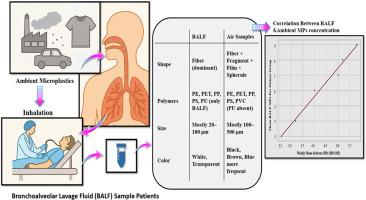Exploring the presence of microplastics in lung lavage of respiratory patients and correlation with airborne microplastics
IF 3.7
2区 环境科学与生态学
Q2 ENVIRONMENTAL SCIENCES
引用次数: 0
Abstract
Microplastics (MPs) are becoming well-known as widespread airborne pollutants with potential consequences for human respiratory health. In this study, we examined the occurrence, morphology, and polymer type of MPs in bronchoalveolar lavage fluid (BALF) samples from 30 patients with respiratory issues in a health care setting in southwestern Iran, in relation to airborne MPs collected contemporaneously from the ambient environment. Individual MPs were separated by the use of chemical digestion and density gradient centrifugation; these were analyzed by Raman spectroscopy and scanning electron microscopy (SEM). Overall, 129 MPs were identified in BALF, with a corrected mean of 3.2 particles/10 mL in BALF; however, the majority were white or transparent fibers ranging from a diameter of 20–100 μm, and were predominantly polyethylene (PE), polypropylene (PP), and polystyrene (PS). Air samples, collected using a high-volume OMNI sampler, ranged from 2.2 to 6.7 MP/m3, while in ambient air variation included shapes and colors with fragments, films, and spherules. Additionally, a statistically significant and strong positive correlation (ρ = 0.996 (p < 0.001)) was found between the weekly ambient MP concentration and the BALF MP counts, supporting inhalation as a likely route of exposure. Both morphologically and polymerically, the airborne MPs will likely pass through and deposit in the lower respiratory tract. These findings highlight the necessity of continued biomonitoring and regulatory concern regarding airborne MPs, particularly in urban and clinical environments.

探讨呼吸系统患者肺灌洗液中微塑料的存在及其与空气中微塑料的关系
微塑料(MPs)作为一种广泛存在的空气污染物,对人类呼吸系统健康具有潜在的影响。在这项研究中,我们检查了伊朗西南部一家医疗机构中30名呼吸系统疾病患者的支气管肺泡灌洗液(BALF)样本中MPs的发生、形态和聚合物类型,并与同期从环境中收集的空气中MPs进行了比较。使用化学消化和密度梯度离心分离单个MPs;用拉曼光谱和扫描电镜对其进行了分析。总体而言,在BALF中鉴定出129个MPs,在BALF中校正平均为3.2个颗粒/10 mL;然而,大多数是直径在20-100 μm之间的白色或透明纤维,主要是聚乙烯(PE),聚丙烯(PP)和聚苯乙烯(PS)。使用大容量OMNI采样器收集的空气样本范围为2.2至6.7 MP/m3,而在环境空气中,变化包括碎片、薄膜和球体的形状和颜色。此外,每周环境MP浓度与BALF MP计数之间存在统计学上显著的强正相关(ρ = 0.996 (p < 0.001)),支持吸入可能是一种暴露途径。在形态和聚合上,空气中的MPs可能通过并沉积在下呼吸道。这些发现强调了继续进行生物监测和对空气中MPs进行监管的必要性,特别是在城市和临床环境中。
本文章由计算机程序翻译,如有差异,请以英文原文为准。
求助全文
约1分钟内获得全文
求助全文
来源期刊

Atmospheric Environment
环境科学-环境科学
CiteScore
9.40
自引率
8.00%
发文量
458
审稿时长
53 days
期刊介绍:
Atmospheric Environment has an open access mirror journal Atmospheric Environment: X, sharing the same aims and scope, editorial team, submission system and rigorous peer review.
Atmospheric Environment is the international journal for scientists in different disciplines related to atmospheric composition and its impacts. The journal publishes scientific articles with atmospheric relevance of emissions and depositions of gaseous and particulate compounds, chemical processes and physical effects in the atmosphere, as well as impacts of the changing atmospheric composition on human health, air quality, climate change, and ecosystems.
 求助内容:
求助内容: 应助结果提醒方式:
应助结果提醒方式:


